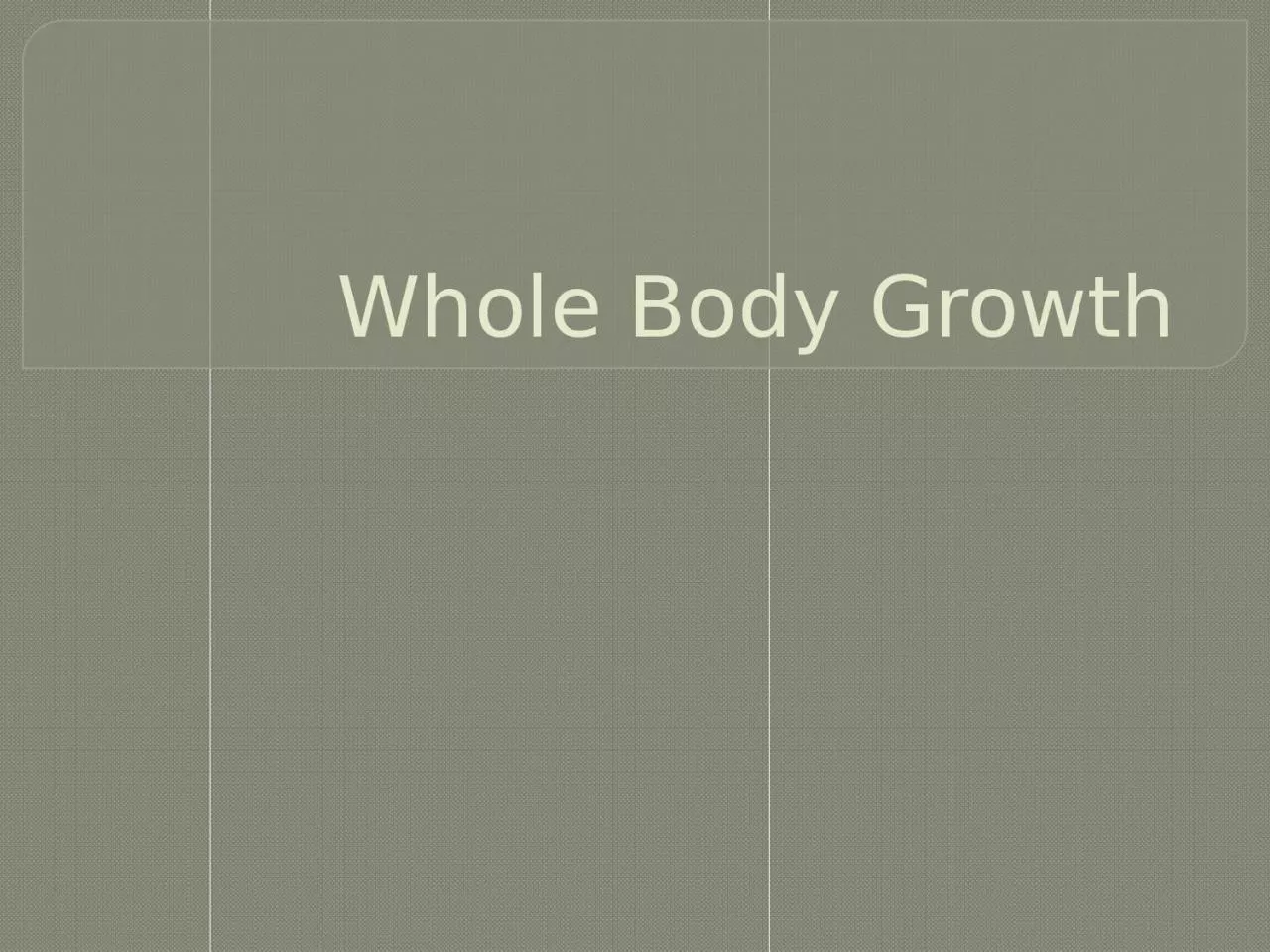

Draw growth curves Explain different changes in body measurements Explain different c hanges is body components Explain different c hanges in carcass components Explain different c hanges in chemical composition ID: 1003003
Download Presentation The PPT/PDF document "Whole Body Growth Objectives" is the property of its rightful owner. Permission is granted to download and print the materials on this web site for personal, non-commercial use only, and to display it on your personal computer provided you do not modify the materials and that you retain all copyright notices contained in the materials. By downloading content from our website, you accept the terms of this agreement.
1. Whole Body Growth
2. ObjectivesDraw growth curvesExplain different changes in body measurementsExplain different changes is body componentsExplain different changes in carcass componentsExplain different changes in chemical composition
3. VideoFoal growth video
4. Growth CurvesRepresents an increase in size relative to a period of time Often impacted on compositional levels of varying tissues Muscle, fat, boneDependent on plane of nutrition and stage of developmentFour phases of growth (figure 9.5)
5. Sigmoidal growth curveWhat do you notice?
6. Age vs MaturityChronological age Age in absolute time e.g. days weeks monthsPhysiological ageStages of development that may be discerned by specific physical or chemical stages of development or functionMaturity is the point in time when an animal reaches its highest level of complexity or developmentAbsolute growth rate: utilizes unitsADG, WDA, Birth, Weaning, etc. (Figure 9.9)Growth rates of various tissues (figure 9.11)
7. Changes in Body MeasurementsQuantifiableThere are measurements specific to the livestock industryCarcass lengthLongissimus muscle areaSubcutaneous fat thicknessCarcass length in pork – valueStandard reference points of measurement
8. Changes in Body ComponentsBody WeightEmpty Body weightDressing PercentageCarcass Weight
9. Body WeightFirst method used to evaluate an animals ability to produce edible productsAlthough not always accurateRumen has a large amount of fillMust withhold feed and water for 24 hours prior to slaughterSecures shrunken weights
10. Empty Body WeightAccounts for the digestive system contentAccomplished by flushing digestive tract and weighing empty tissues
11. Dressing PercentageDressing the animal During slaughter portions of the animal are removedInternal organs, hide, feet and headMost important pieces remainingMuscle, bone, and fatDressing percentage is calculated by dividing the carcass weight by the shrunken live weight of the animal
12. Carcass WeightCarcass weight as growth end point is highly desirableCarcass weight is routinely used as a primary end pointMuscle, bone, fat
13. Changes in carcass componentsThe composition of the carcass has a major effect on economic value of the animalGrowth of individual carcass components (muscle, bone, and fat) may be plotted against time to better characterize these differences.
14. Changes in carcass components
15. Changes in carcass componentsBone- increases at a decreasing rateMuscle is the fastest growing during early life and post weaning, yet decreases with timeFat is the fastest growing at physiological maturityA decrease in bone and muscle is due to the extreme increase in fat percentage
16. Changes in the Chemical CompositionChemical Composition changes with time and weightBecause bone, muscle, and fat are deposited at different ratesMuscle ranges from 68-85% waterMoisture to protein ratio = 4:1CT increases with ageMuscle fibers increase in size, yet CT decreases in percent thus increases in size FatMore variable yet accumulates in various depots with age including the depots associated with muscle
17. Factors affecting Carcass compositionGeneticsSpeciesSelection and domesticationMuscle distributionFat distributionBreedFrame sizeSex
18. GeneticsMutation or intensive selectionInfluence of environmentPhenotype versus genotypeHeritability estimates
19. SpeciesVariation between species Deposition of tissues, especially fatOrder of fat deposition between speciesProportion of composition compared anatomicallyValue differences among composition parts of each species
20. Muscle distributionComparison of muscle distribution between speciesRuminant versus non-ruminant Domestic versus non-domesticated speciesMeat versus milk type selection
21. Fat distributionSpecies is a major determinant in fat depositionAt the beginning, carcass fat is fairly even in distributionHowever, a growth increases and maturity develops fat begins to accumulate varying percentages at different anatomical locations
22. Breed VariationsVarious breeds have:Different maturity patternsFrame sizesMeat versus dairy typeSelection pressure for muscling
23. Frame SizeGrowth patterns Feedlot gain and efficiencyChronological vs Physiological maturityQuality Grade vs fat depositionCompositional EndpointsDairy vs Meat typeDressing Percentage variationsForage availability and utilization
24. Frame size
25. Frame Size
26. SexExcept for pigs, females mature earliestIntact males have a greater proportion of muscles in the forequarter while heifers in the proximal pelvic limbCastrated males are intermediateHeifers at the same physiological slaughter age and maturity will be fatter lower yielding
27. ObjectivesDraw growth curvesExplain different changes in body measurementsExplain different changes is body componentsExplain different changes in carcass componentsExplain different changes in chemical composition